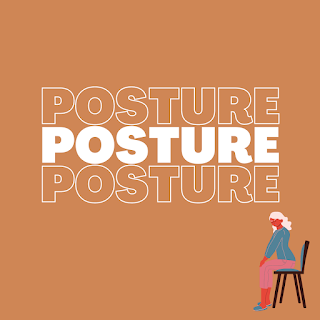Posture, Posture, Posture
Over the past weekend, my best friend Kareena was in town to visit me! We had quite the adventure and explored the Grind City by going to places like the Pyramid (of course we had to) and had some excellent food. Coincidentally, she came to visit me right after we had a lecture on "Posture" in our Biomechanics class. At this point, I have been starting to be aware of my own posture as well as noticing other people's posture. I had told Kareena about this assignment and she volunteered to be my test client as I took note of her posture throughout our time together! Here are some pictures of her from our time together and times when I noticed her posture below:

Photo 4: Kareena looking at her phone while sitting on my desk
In Photo 4, Kareena was concentrated on what she was looking at on her phone that she had no idea her posture alignment was a bit exaggerated. As she was sitting, she had an excessive amount of thoracic kyphosis within her spine curve. Her head is forward and resting on her left knee so she isn't holding her head weight. Her pelvis is tilted posteriorly as her left femur is flexed causing hip flexion and also internally rotated and adducted. Her right femur is externally rotated and slightly abducted away from her as well as flexed, causing knee flexion. Both of her scapulae are protracted and abducted.
This position is mostly for stability rather than mobility since she is stable from her point of contact with the chair and her right leg on the floor. Her body is fixed and supported. She does have a large base of support since she is in contact with the chair and has one leg touching the chair and the opposite leg grounded on the floor.
As she has one leg propped on the chair and one leg remaining on the floor, it should not be too hard to change out of this position as she can bring her left leg back to the floor to transition into the normal seating posture and have more of a larger base of support than what she has in the picture. She can return to normal position by returning her pelvis to neutral and allowing herself to distribute equal weight on her ischial tuberosities as well as having her shoulders stay in a symmetrical position, anterior to her hips. Her upper extremities are in a good range of free movement as they are not really supported by her or anything else. As she is checking her phone, she has the ulnar side of her right hand slightly resting on the table as she scrolls, which is simply just allowing the hand to be steady while she scrolls. Her left arm is simply hanging by her side. This posture does not fully support joint alignment as Kareena has her spine curving excessively concave forward and causing compression on the anterior portion of the intervertebral discs. If she does not evenly distribute weight through her ischial tuberosities, her hip joints could start to cause pain as well.
I believe Kareena could stay in this position for about five to at least ten minutes until she begins to shift just because she has support from the chair and her head resting on her leg to hold her head weight. However, having one leg up and one leg down can start to get uncomfortable as her weight is mostly on her right ischial tuberosity in the picture, and will need to relieve that pressure. Her neck muscles will also start to hurt from being overstretched as her head is so forward and not directly over her trunk and she will need to either lift it up or stretch it out after a few minutes.
Proper posture and proper body mechanics are very important in everyday life as we have to take care of how our body moves throughout the day. We have to be aware of how we sit or stand for long periods of time and make sure we don't damage our muscles if we are lifting heavy items. The back is one of the most injured body parts and it is important to make sure when lifting loads of any weight, you are using the correct posture and have the item load closer to your body. Another reason it is important to teach proper posture and body mechanics is to prevent abnormal development of bone, muscle, tendons, ligaments, or other soft tissue. This would also help achieve an ideal body alignment if you have the correct posture and can allow muscles and abdominal organs to function optimally.
Kareena is actually starting grad school in August for interior design and I know she will probably be having late nights studying and sitting at a desk for long periods of time. I would advise her, or anyone that has a desk job, to get a laptop stand that could help her keep her eye level with her laptop screen so she does not have to naturally look down and cause an overstretching of muscles. This will also help her keep her posture properly aligned and allow equal weight distribution. This will enhance her sitting posture appearance and promote social participation. When it comes to teaching proper body mechanics, I would emphasize how important it is to maintain the curves of our back since we do not want to injure that area, especially when it comes to lifting heavy items. For a client that has to lift heavy objects continuously throughout the day, I would emphasize that the item load needs to be closer to the body and to have a wide leg stance for a large base of support. It would also help to keep knees bent and keep the core tight to maintain an upright posture.
References:
Weisser- Pike, O. (2023) Lecture 8 Vertebral Column, Posture, and Body Mechanics [PowerPoint
presentation].







Comments
Post a Comment